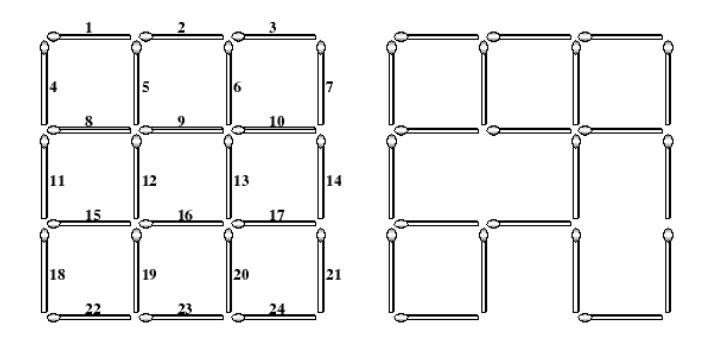破坏正方形UVA1603
题目大意
有一个由火柴棍组成的边长为n的正方形网格,每条边有n根火柴,共2n(n+1)根火柴。从上至下,从左到右给每个火柴编号,现在拿走一些火柴,问在剩下的后拆当中ongoing,至少还要拿走多少根火柴才能破坏掉所有的正方形?

虽然本题的数据规模不大,但是却有多种选择火柴棍的方法,导致如果直接爆搜的话会炸,因此考虑采用IDA*算法。
首先来看,我们该如何存储这个火柴棍图?
个人比较喜欢把这样一个火柴棍图转化成这样的数组形式,存为square[][]
0 1 0 1 0 1 0
1 0 1 0 1 0 1
0 1 0 1 0 1 0
1 0 1 0 1 0 1
0 1 0 1 0 1 0
1 0 1 0 1 0 1
0 1 0 1 0 1 0
其中,0代表火柴棍交界的地方,1代表火柴棍。
先给所有火柴棍编上号。在a上遍历,按序命名,用一个map<pair<int,int>,int> name进行映射
之后,给每一个正方形编一个号,在用一个vector存一下每个正方形的所有边,便于进行搜索时快速确定本次该删除哪一条边。在存储边的同时,还要记录下当前这个正方形的原大小(即火柴棍全部摆满)和现在的大小(删除火柴棍后的数量),比较这两个的大小即可确定现在这个正方形是否被破坏。存储过程用函数实现
点击查看代码
void get(int x,int y,int len,int ccnt) {//搜正方形,并把组成正方形的每个火柴添加上当前的正方形
int tx = x,ty = y;
for(ty = y; ty <= 2 * n + 1; ty++){//向右走
if(cnt == len){cnt = 0;break;}
if(square[tx][ty]){
cnt++;
match[ccnt].push_back(name[make_pair(tx,ty)]);
}
}
for(tx = x; tx <= 2 * n + 1; tx++){//向下走
if(cnt == len){cnt = 0;break;}
if(square[tx][ty]){
cnt++;
match[ccnt].push_back(name[make_pair(tx,ty)]);
}
}
for(ty; ty >= 1; ty--){//向左走
if(cnt == len){cnt = 0;break;}
if(square[tx][ty]){
cnt++;
match[ccnt].push_back(name[make_pair(tx,ty)]);
}
}
for(tx; tx >= 1; tx--){
if(cnt == len){cnt = 0;break;}
if(square[tx][ty]){
cnt++;
match[ccnt].push_back(name[make_pair(tx,ty)]);
}
}
}
在实现当中,可以看见我们使用了memcpy这个函数,它可以将一个数组内的值复制到另一个数组里面,挺方便的
点击查看代码
#include<bits/stdc++.h>
using namespace std;
const int MAXN = 22;
int t,n;
bool square[MAXN][MAXN],use[MAXN * MAXN];//vis表示正方形i是否被破坏 ,use表示该火柴棍是否被使用
int cnt,now,del;
map<pair<int,int>,int> name;
bool found;
bool tmp[MAXN * MAXN];
vector<int> match[MAXN * MAXN];//编号i的正方形由哪些火柴棍组成
void get(int x,int y,int len,int ccnt) {//搜正方形,并把组成正方形的每个火柴添加上当前的正方形
int tx = x,ty = y;
for(ty = y; ty <= 2 * n + 1; ty++){//向右走
if(cnt == len){cnt = 0;break;}
if(square[tx][ty]){
cnt++;
match[ccnt].push_back(name[make_pair(tx,ty)]);
}
}
for(tx = x; tx <= 2 * n + 1; tx++){//向下走
if(cnt == len){cnt = 0;break;}
if(square[tx][ty]){
cnt++;
match[ccnt].push_back(name[make_pair(tx,ty)]);
}
}
for(ty; ty >= 1; ty--){//向左走
if(cnt == len){cnt = 0;break;}
if(square[tx][ty]){
cnt++;
match[ccnt].push_back(name[make_pair(tx,ty)]);
}
}
for(tx; tx >= 1; tx--){
if(cnt == len){cnt = 0;break;}
if(square[tx][ty]){
cnt++;
match[ccnt].push_back(name[make_pair(tx,ty)]);
}
}
}
bool _check(int i){
for(int j=0;j<match[i].size();++j){
if(use[match[i][j]])
return 0;
}
return 1;//没被破坏
}
bool check(int i){
for(int j=0;j<match[i].size();++j){
if(tmp[match[i][j]])
return 0;
}
return 1;
}
void init(){
name.clear();
for(int i = 1; i < MAXN*MAXN; i++)match[i].clear();
memset(square,0,sizeof square);
memset(use,0,sizeof use);
memset(tmp,0,sizeof tmp);
}
int estimate(){
int sum = 0;
memcpy(tmp,use,sizeof(use));
for(int i = 1; i <= now; i++){
if(check(i)){
sum++;
for(int j=0;j<match[i].size();++j)
tmp[match[i][j]]=1;
}
}
return sum;
}
void IDAstar(int x,int maxd){
if(x+estimate()>maxd)return;
for(int i=1;i<=now;++i){
if(_check(i)){
for(int j=0;j<match[i].size();++j){
use[match[i][j]]=1;
//v.push_back(id[i][j]);
IDAstar(x+1,maxd);
//v.pop_back();
use[match[i][j]]=0;
if(found)return;
}
return;
}
}
found=1;
return;
}
int main(){
cin >> t;
while(t--){
init();
cin >> n;
bool flag = 0;
cnt = now = 0;
for(int i = 1; i <= 2 * n + 1; i++){//构造正方形图并给火柴棍编号
if(i % 2 == 0)flag = 1;
for(int j = 1; j <= 2 * n + 1; j++){
square[i][j] = flag;
if(flag == 1){
cnt++;
name[make_pair(i,j)] = cnt;
}
flag = !flag;
}
}
cnt = 0;
for(int i = 1; i <= 2 * n + 1; i++){//寻找正方形
if(i % 2 == 0)continue;
for(int j = 1; j <= 2 * n + 1; j++){
if(!square[i][j])continue;
for(int len = 1; len <= n; len++){
if((i + 2 * (len - 1) + 1 > 2 * n + 1) || (j + 2 * (len - 1) + 1 > 2 * n + 1))break;
now++;
get(i,j,len,now);
}
}
}
cin >> del;
int a;
for(int i = 1; i <= del; i++){
cin >> a;
use[a] = 1;
}
for(int i = estimate();;i++){
found = 0;
IDAstar(0,i);
if(found){
cout << i << "\n";
break;
}
}
}
}

